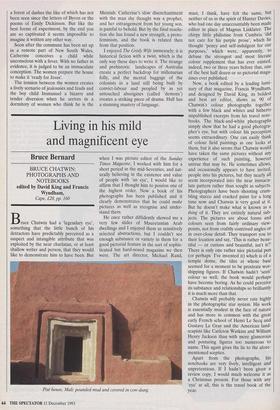Living in his mild and magnificent eye
Bruce Bernard
BRUCE CHATWIN: PHOTOGRAPHS AND NOTEBOOKS edited by David King and Francis Wyndham, Cape, £20, pp. 160 Bruce Chatwin had a 'legendary eye', something that the little bunch of his detractors have predictably perceived as a suspect and intangible attribute that was exploited by the near charlatan, or at least shallow writer and person, that they would like to demonstrate him to have been. But Pise house, Mali: pounded mud and covered in cow-dung. when I was picture editor of the Sunday Times Magazine, I worked with him for a short period in the mid-Seventies, and nat- urally believing in the existence and value of people with 'an eye', I would like to affirm that I thought him to possess one of the highest order. Now a book of his photographs has been published and it clearly demonstrates that he could make pictures as well as recognise and under- stand them.
He once rather diffidently showed me a very few slides of Mauretanian Arab dwellings and I enjoyed them as sensitively selected abstractions, but I couldn't see enough substance or variety in them for a good pictorial feature in the sort of sophis- ticated but hard-nosed magazine we then were. The art director, Michael Rand, must, I think, have felt the same, but neither of us in the spirit of Hunter Davies, who had one day unaccountably been made editor in place of Magnus Linklater. The chirpy little philistine from Cumbria `did not care for his purple prose', which he thought 'poncy and self-indulgent for our purposes,' which were, apparently, to debase the strongest and most literate colour supplement that has ever existed, indeed, two or three years before that, one of the best half dozen or so pictorial maga- zines ever published.
Now, a book edited by a leading lumi- nary of that magazine, Francis Wyndham, and designed by David King, its boldest and best art editor, shows us 90 of Chatwin's colour photographs together with a few black and whites and hitherto unpublished excerpts from his travel note- books. The black-and-white photographs simply show that he had a good photogra- pher's eye, but with colour his perception seems extraordinary. One can easily think of colour field paintings as one looks at them, but it also seems that Chatwin would have taken the same pictures without any experience of such painting, however untrue that may be. He sometimes allows, and occasionally appears to have invited, people into his pictures, but they nearly all seem incorporated into the near immacu- late pattern rather than sought as subjects. Photographers have been shooting crum- bling stucco and cracked paint for a long time now and Chatwin is very good at it. But he doesn't make what is known as a thing of it. They are entirely natural sub- jects. The pictures are about forms and colours seen from fairly ordinary view- points, not from craftily contrived angles or in over-close detail. They transport you to their location and say, 'This is rather beau- tiful — or curious and beautiful, isn't it?' There is only one rather nice pictorial pun (or perhaps I've invented it) which is of a temple dome, the tiles at whose base seemed for a moment to be prostrate wor- shipping figures. If Chatwin hadn't 'seen' colour so well, the book would perhaps have become boring. As he could perceive its substance and relationships so brilliantly it is much more than that.
Chatwin will probably never rate highly in the photographic star system. His work is essentially modest in the face of nature and has more in common with the great early French school of Henri Le Secq and Gustave Le Gray and the American land- scapists like Carleton Watkins and William Henry Jackson than with more glamorous and posturing figures too numerous to name. This again gives the lie to the afore- mentioned sceptics.
Apart from the photographs, his notebooks are very lively, intelligent and unpretentious. If I hadn't been given a review copy, I would much welcome it as a Christmas present. For those with any 'eye' at all, this is the travel book of the year.


































































 Previous page
Previous page